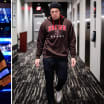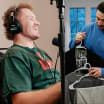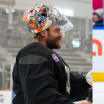Andersen's preferred method was to seal the post with the bottom edge of his pad (called the toe box) against the post and the toe of his skate just inside it, while others prefer to place the bottom of their skate blade on the post, and some use the shin of their pad. Each has strengths and weaknesses, a balance between sealing the post and improved mobility off it.
Andersen used to spend most of his practice time trying to perfect his preferred method, but after studying the post-play habits of other top goalies and looking at sharp-angle goals with Briere, they realized perfect execution wasn't always possible, especially during scrambles. So instead of always focusing on his preferred method, they've tried to perfect them all.
"It's such an unpredictable game and when you set up drills in practice it's usually controlled and it's dialed in to working on a specific thing," Andersen said, "but what we've been trying to do is just work on a few different ways to do things.
"Let's say you have one thing you prefer that you do to a 100 percent comfortability and you're only at 50 percent on the other two, but if you can work the other two up to close to the same and feel 100 percent comfortable in every situation then you have really nothing to worry about, you just go out there and play."
They applied it to other areas, which Andersen believes also makes it harder to scout his tendencies because he often gives shooters a different look from the same location.
"It's a fast sport and it goes faster and faster," he said, "and if you can find a way to still make saves and feel comfortable when you're not perfect then you're going to a better chance of saving the puck, which eventually at the end of the day is what matters, right?"
Like the Navy SEAL Hell Week, it's about being comfortable in uncomfortable situations.


















